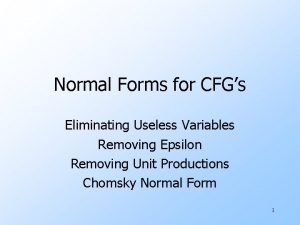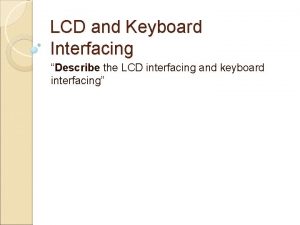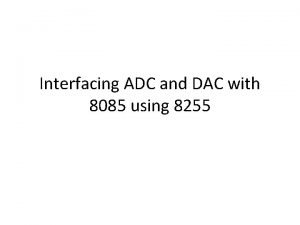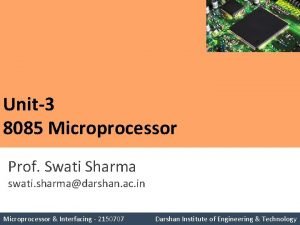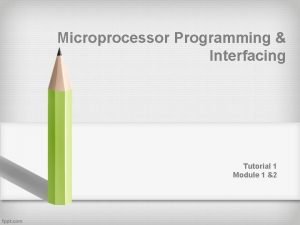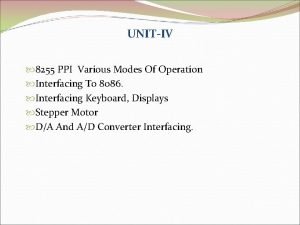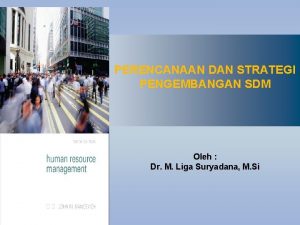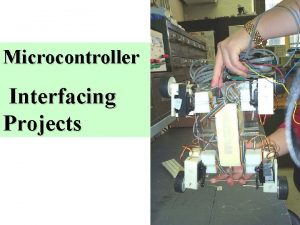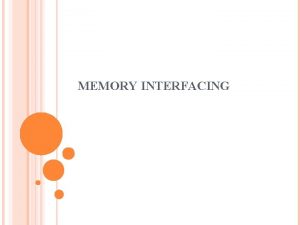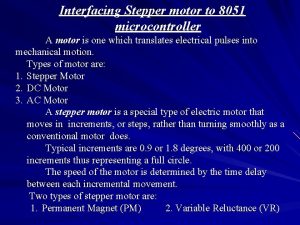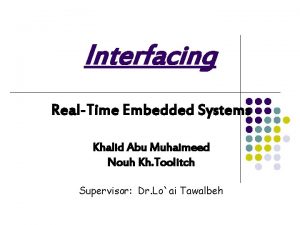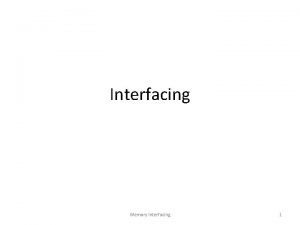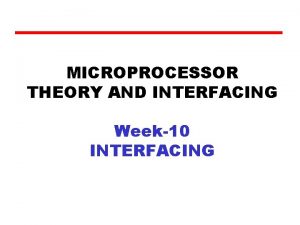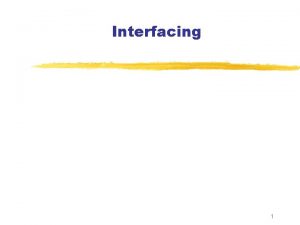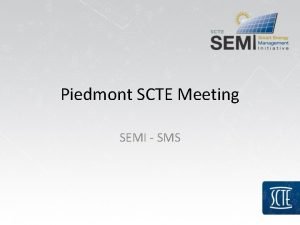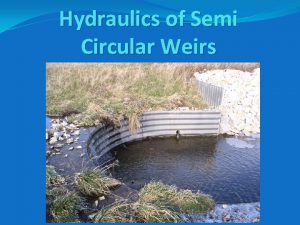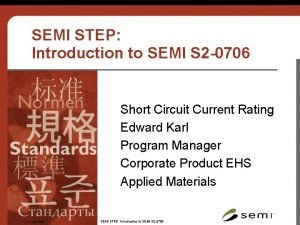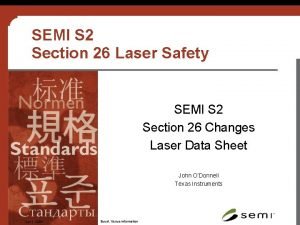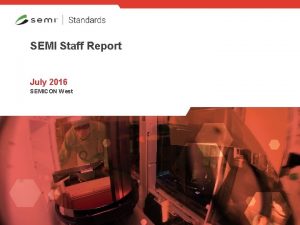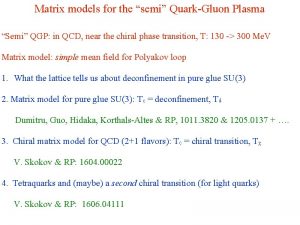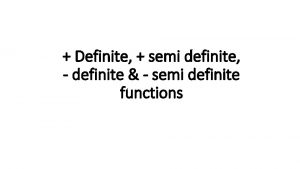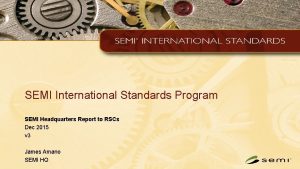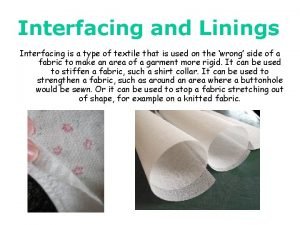SEMI why and what Overview Interfacing grammars to







![SEM-I: semantic interface n n Formal level: MRS/RMRS syntax and semantics, naming conventions (_lemma_POS[_sense]) SEM-I: semantic interface n n Formal level: MRS/RMRS syntax and semantics, naming conventions (_lemma_POS[_sense])](https://slidetodoc.com/presentation_image/705956f4ccc0ec3ddfd900cd87acfbd4/image-8.jpg)






![Semi-automated documentation [incr tsdb()] Lex DB grammar Object-level SEM-I Documentation strings and semantic test-suite Semi-automated documentation [incr tsdb()] Lex DB grammar Object-level SEM-I Documentation strings and semantic test-suite](https://slidetodoc.com/presentation_image/705956f4ccc0ec3ddfd900cd87acfbd4/image-15.jpg)





- Slides: 20

SEM-I: why and what?

Overview Interfacing grammars to other systems via semantics: requirements n What is in the SEM-I? n SEM-I tools n Some modest proposals. . . n SEM-I ++ n

Modular architecture Language independent component Meaning representation (MRS/RMRS) Language dependent analysis/realization (DELPH-IN grammar) string

Semantics as interface n Applications need to know what representations to expect / deliver: n n Deep/shallow integration via RMRS n n n transfer component for MT query answering information extraction, etc RMRS from shallow grammars is an underspecified form of semantics from deep grammars treats deep grammars as normative, so need to know their output Explaining what we’re doing!

What must be specified n n n Syntax of representation (XML) Formalism (MRS/RMRS) Naming conventions Attributes and values on variables Relations, features, constant values, variable sorts, optionality n n n `grammar’ relations (e. g. , udef_q_rel) open-class relations (e. g. , _interview_v_rel) Hierarchy of relations (where motivated by denotation)

Consultants were interviewed by Abrams <mrs> <var vid='h 1'/> <ep><pred>prpstn_m_rel</pred><var vid='h 1'/> <fvpair><rargname>MARG</rargname><var vid='h 3'/></fvpair></ep> <ep><pred>udef_q_rel</pred><var vid='h 6'/> <fvpair><rargname>ARG 0</rargname><var vid='x 4'/></fvpair> <fvpair><rargname>RSTR</rargname><var vid='h 7'/></fvpair></ep> <ep><pred>_consultant_n_rel</pred><var vid='h 9'/> <fvpair><rargname>ARG 0</rargname><var vid='x 4'/></fvpair></ep> <ep><pred>_interview_v_rel</pred><var vid='h 10'/> <fvpair><rargname>ARG 0</rargname><var vid='e 2'/></fvpair> <fvpair><rargname>ARG 1</rargname><var vid='x 11'/></fvpair> <fvpair><rargname>ARG 2</rargname><var vid='x 4'/></fvpair></ep> <ep><pred>_by_p_cm_rel</pred><var vid='h 10'/> <fvpair><rargname>ARG 0</rargname><var vid='e 13'/></fvpair> <fvpair><rargname>ARG 1</rargname><var vid='u 12'/></fvpair> <fvpair><rargname>ARG 2</rargname><var vid='x 11'/></fvpair></ep> <ep><pred>proper_q_rel</pred><var vid='h 14'/> <fvpair><rargname>ARG 0</rargname><var vid='x 11'/></fvpair> <fvpair><rargname>RSTR</rargname><var vid='h 15'/></fvpair></ep> <ep><pred>named_rel</pred><var vid='h 17'/> <fvpair><rargname>ARG 0</rargname><var vid='x 11'/></fvpair> <fvpair><rargname>CARG</rargname><constant>abrams</constant></fvpair></ep> <hcons hreln='qeq'><hi><var vid='h 3'/></hi><lo><var vid='h 10'/></lo></hcons> <hcons hreln='qeq'><hi><var vid='h 7'/></hi><lo><var vid='h 9'/></lo></hcons> <hcons hreln='qeq'><hi><var vid='h 15'/></hi><lo><var vid='h 17'/></lo></hcons> </mrs>

Some issues n Specification/documentation: n n n treatment of bare plural, message relations defining when such relations are present arity and correspondence of arguments for _interview_v_rel etc `unwanted’ predicates such as _by_p_cm_rel (some of these are going/gone – can all be avoided? ) qeqs etc – can be ignored for analysis for some applications, not for realisation (currently) changes to grammars: e. g. , message relations?
![SEMI semantic interface n n Formal level MRSRMRS syntax and semantics naming conventions lemmaPOSsense SEM-I: semantic interface n n Formal level: MRS/RMRS syntax and semantics, naming conventions (_lemma_POS[_sense])](https://slidetodoc.com/presentation_image/705956f4ccc0ec3ddfd900cd87acfbd4/image-8.jpg)
SEM-I: semantic interface n n Formal level: MRS/RMRS syntax and semantics, naming conventions (_lemma_POS[_sense]) Meta-level: variable feature values; manually specified `grammar’ relations n n n udef_q_rel (construction) named_rel, proper_q_rel (`fixed’ lexical relations) Object-level (e. g. , _consultant_n_rel)

SEM-I and grammars n n Object levels SEM-Is are auto-generated and distinct for each grammar Meta-level SEM-Is should be (partially) shared object meta SEM-I object SEM-I

SEM-I functionality n Offline n n Definition of `correct’ (R)MRS for developers Documentation Checking of test-suites Online n n n SEM-I plus lexical link used in lexical lookup phase of generation (already) rejection of invalid (R)MRSs (input to generator, deep/shallow integration) patching up input to generation, fixing up output from parser

SEM-I: implementation (current and planned) n Database of relations, features, value sorts, optionality: n n n Meta-level: plan to generate from grammars, with manual identification of relations (some relations are grammar-internal, see later) and manual documentation Object-level: auto-generated from lexical entries in deep grammars (current version is based on generator code – optionality not there yet) Semantic test suite exemplifying grammar relations (partial for ERG, in progress for other grammars)

SEM-I development n n SEM-I development must be incremental SEM-I eventually forms the `API’: stable, changes negotiated. n n n Grammar writers need flexibility to hide things, make changes: SEM-I only constrains the external view n n Shared meta-level SEM-I is presumably part of Matrix, but negotiated with consumers Management needs to be worked out BUT: automate production of SEM-I from grammars as much as possible Documentation needs to be automated as much as possible: documentation by example

Interface n External representation: (R)MRSSEM-I n n n public, documented reasonably stable Internal representation n mapping to feature structures (MRSFS) • MRSSEM-I to MRSFS mapping needed anyway, but may have to go via MRSINTERNAL to MRSFS mapping n distinctions between relations which are irrelevant for denotation are hidden: only some relations are public • e. g. , `selected for’ relations are internal only n External/Internal inter-conversion n n e. g. , internal-only relation automatically converted to supertype in output BUT: want to minimize the discrepancies n relation hierarchies in SEM-I consistent with grammar hierarchies

Architecture with indirection External LF (defined by SEM-I) Internal LF parser/generator String bidirectional mapping
![Semiautomated documentation incr tsdb Lex DB grammar Objectlevel SEMI Documentation strings and semantic testsuite Semi-automated documentation [incr tsdb()] Lex DB grammar Object-level SEM-I Documentation strings and semantic test-suite](https://slidetodoc.com/presentation_image/705956f4ccc0ec3ddfd900cd87acfbd4/image-15.jpg)
Semi-automated documentation [incr tsdb()] Lex DB grammar Object-level SEM-I Documentation strings and semantic test-suite Auto-generate examples semi-automatic examples, autogenerated on demand Documentation Meta-level SEM-I autogenerate

Hierarchies n n n Type hierarchies of relations in grammars are not there to support inference GLB condition not needed for SEM-I Proposal: basic SEM-I hierarchy of grammar relations derived automatically from grammar type hierarchy plus marking of relations as in SEM-I. (Possibly augmented in SEM-I ++, see later) type 1 type 3 type 2 type 4 grammar type 2 type 5 type 4 SEM-I type 5

Proposals n n n Documentation on wiki, mailing list for SEM-I developers and consumers MRS code to support particular TFS encoding of MRSs and enforce naming conventions, simplifying basic MRS FS to MRS mapping and making grammars more consistent Allow substantive MRSINTERNAL to MRSSEM-I mapping (via transfer rule mechanism), but hope to keep this minimal since it hinders deep/shallow integration. Agreed procedure for adding/changing variable features and values Inventory of grammar predicates: extensions/changes by grammar developers require notification and documentation

Change protocol (initial proposal) A developer (grammar developer or software developer) implementing a change which will affect the SEM-I must follow the protocol: n Consultation (meta-SEM-I only). Proposed changes to the meta -SEMI-I must be discussed on the mailing list. n Notification. All changes to the SEM-I (meta and object) must be posted on the website. n A script for conversion from new to old version must be posted (unless an incompatible change is agreed by the list members) n Testing. For each grammar, there will be a semantic test suite, with agreed SEM-I output (for a specified reading). All changes to a grammar must be validated against the corresponding testsuite. All software changes must be validated against all testsuites. The conversion script must also be validated. n Commit changes.

Applications and the SEM-I n Application code will be isolated from grammar changes MT: semantic transfer – mapping from one SEM-I to another n IE: mapping from SEM-I to template (often ignoring much of the detail in the original MRS) n QA: matching RMRSs: SEM-I hierarchy used for compatibility tests (also SEMI ++) n

SEM-I++ (aka Floyd) n n n SEM-I++ is not built by grammar developers, depends on SEM-I, not grammars More semantics, domain-independent, shared between applications Might include: n n Definitions of grammar relations and closed-class relations to support inference Mapping to external resources (e. g. , Word. Net and Frame. Net) Enriched hierarchies Word classes • word classes could support a richer encoding of thematic role e. g. , experiencerstimulus psych verbs map ARG 1 to EXP and ARG 2 to STIM n n Plan is to support specification of SEM-I++ in some version of OWL SEM-I++ information is additional to grammars but DELPH-IN community may agree to support it
 Hey bye bye
Hey bye bye Unrestricted grammar
Unrestricted grammar Questions on context free grammar
Questions on context free grammar Which grammar generates regular language
Which grammar generates regular language Eliminating useless symbols
Eliminating useless symbols Types of grammar
Types of grammar Don't ask why why why
Don't ask why why why Lcd and keyboard interfacing
Lcd and keyboard interfacing Adc interfacing with 8255
Adc interfacing with 8255 What is peripheral and interfacing
What is peripheral and interfacing Microcontroller interfacing to dac diagram
Microcontroller interfacing to dac diagram 8085 pins
8085 pins Microprocessor and interfacing tutorial
Microprocessor and interfacing tutorial Adc and dac interfacing with 8051
Adc and dac interfacing with 8051 4*4 matrix keyboard interfacing with 8255
4*4 matrix keyboard interfacing with 8255 Interfacing adc with 8086
Interfacing adc with 8086 Interfacing sdm adalah
Interfacing sdm adalah Interfacing projects
Interfacing projects 8085 interfacing
8085 interfacing Interfacing 8051 with stepper motor
Interfacing 8051 with stepper motor Interfacing in embedded systems
Interfacing in embedded systems




